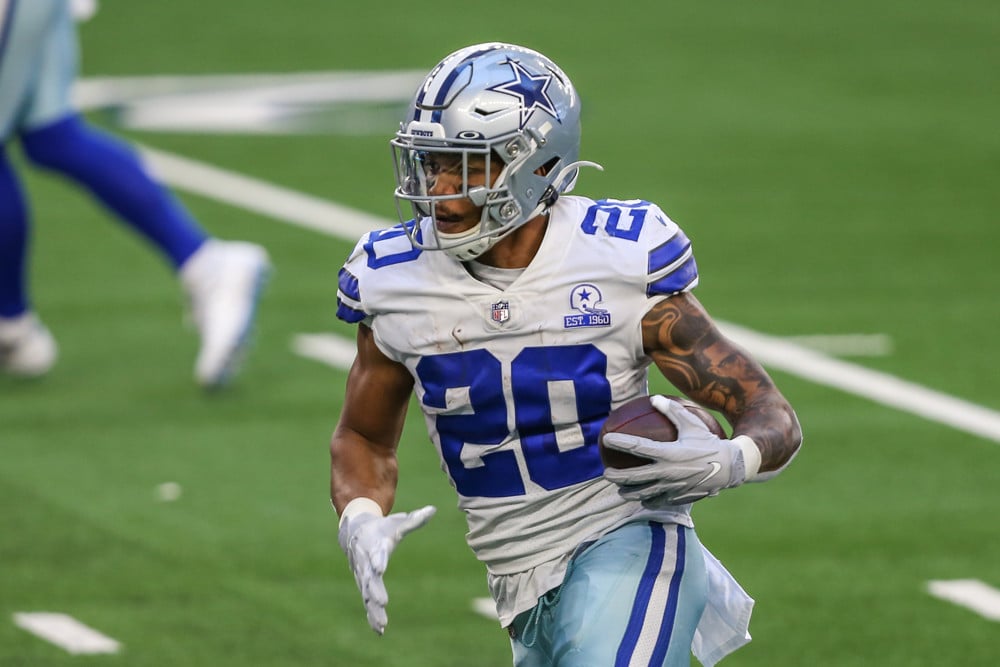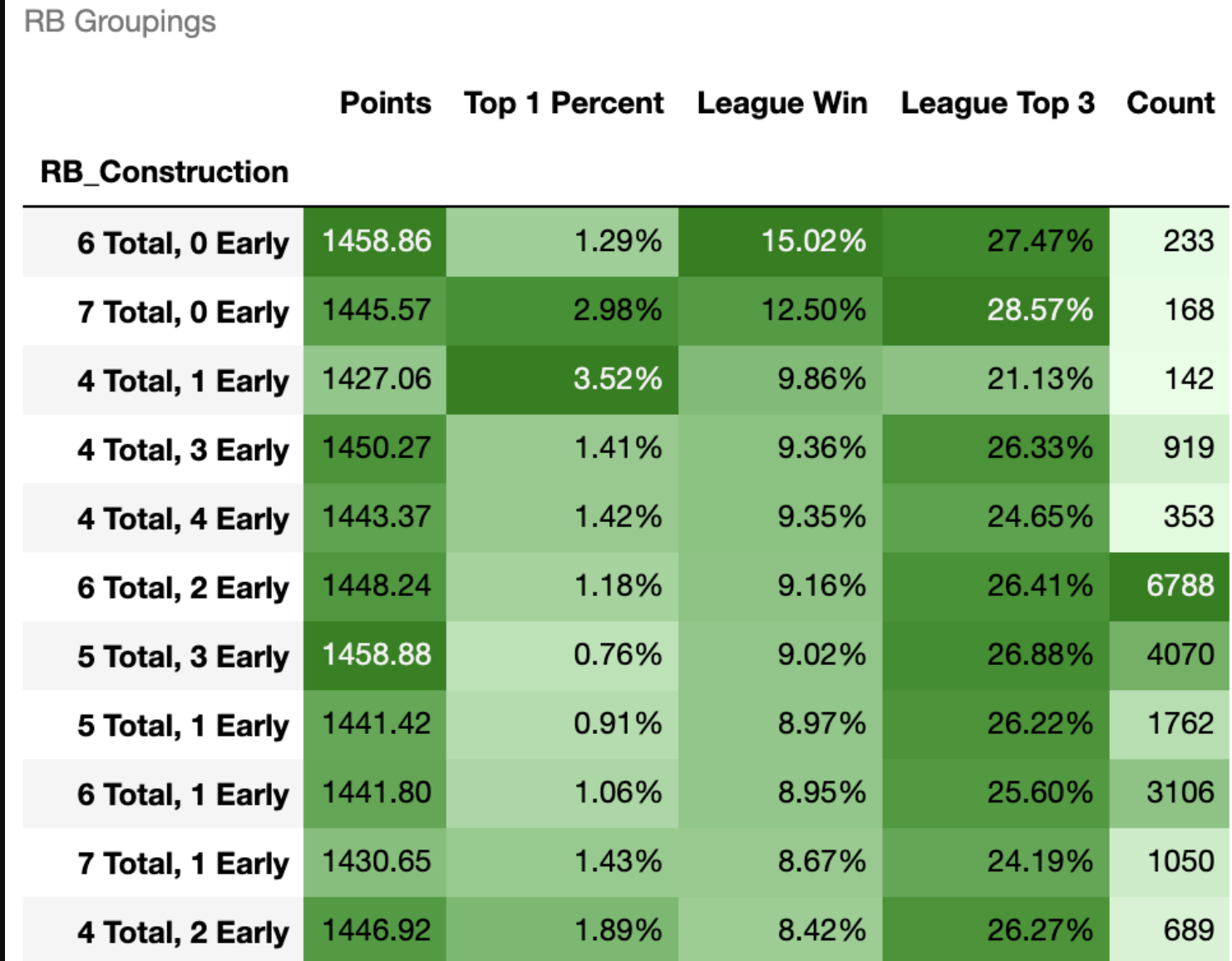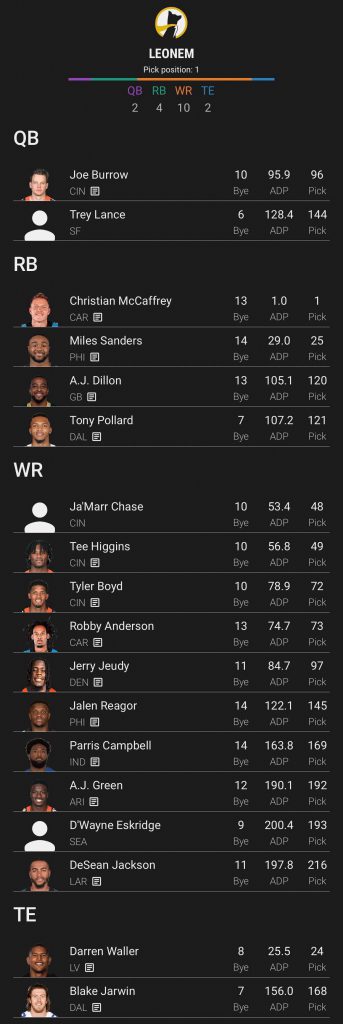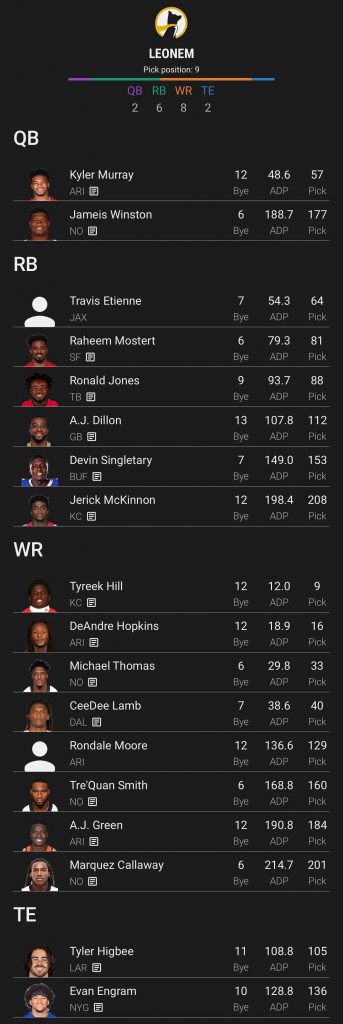IMPORTANT Editor’s Note for NFL FANTASY PLAYERS: Underdog Fantasy is offering ALL ETR subscribers an unbeatable deal! Anyone who purchases the ETR Draft Kit will receive a $10 site credit. First-time Underdog customers will receive an additional $25, making our Draft Kit nearly free if you haven’t tried Underdog yet! After purchasing our Draft Kit, follow the instructions here to claim your reward.
Last draft season, I looked at the viability of the Zero RB strategy on Underdog. I ended up presenting a case against Zero RB to an extent and for a Hyper Fragile RB approach, which I outlined thoroughly. Fast forward a year, and my thoughts have changed somewhat:
- I’m more convinced than ever that the Hyper Fragile RB strategy works.
- I’m tweaking the strategy I outlined last season to devote even less draft capital to the RB position.
- Zero RB drafts are more viable than I initially considered, especially as the Hyper Fragile strategy gains more traction.
Before I dive into more detail on those specific thoughts, it’s important to remind ourselves of the basic tenets of each strategy. These strategies seem like opposites but are rooted in the same ideals. From my article last season, I wrote:
“The Anti-Zero RB strategy is rooted in some of the same tenets as the Zero RB strategy. We’re simply choosing to take advantage of the risk/reward dynamic in different ways.”
The Zero RB Strategy Accounts for:
- High-Ceiling RB Production Via Multiple RB Stashes/Waiver Wire Churn
- High-Ceiling WR Production Via Premium Pick Investment
- RB Risk Via Limited Premium Pick Investment
The Hyper Fragile RB Strategy Accounts for:
- High-Ceiling RB Production Via Premium Pick Investment
- High-Ceiling WR Production Via Quantity Investment
- RB Risk Via Limited Quantity Investment
Let’s look at each strategy a little closer now, specifically dictated to Underdog:
Hyper Fragile RB Strategy
- Draft RBs early
- Don’t draft a lot of RBs
- Make up for lack of WR quality with quantity
The idea behind the Hyper Fragile RB strategy is simple. If your early RB picks hit (or just don’t bust), you’ve structured optimally around that, creating a massive ceiling. Only drafting ~ 4 RBs allows you to take some chances on an elite QB or TE early while compiling 9-10 WRs. Any additional RB capital would be wasted for the most part. The marginal value add to your weekly scores is minimal in the scenario where your early backs stay healthy and are even moderately productive. In scenarios where your early backs do bust, your win rate plummets anyways. Adding an extra 1-2 RBs later on doesn’t do much to make up for that, but it does really hurt your win rate in the other scenario because it takes away from your WR spots, which are reliant on depth.
Zero RB Strategy
- Don’t draft RBs early
- Maximize investments in elite WRs/QB/TE (ideally two of the three)
- Grab a mixture of “Zero RB candidates”, later-round RBs who serve a specified purpose — immediate production, TD equity in a good offense, high-end handcuff upside, receiving production, etc.
The idea behind the Zero RB strategy is that there is a disproportionate risk/reward dynamic with RBs, in large part because it’s a position that is dependent on health and coaching decisions (volume) as opposed to skill in a vacuum. Early RBs bust in a big way if they lose volume, while late-round RBs can provide a massive ROI when thrust into the correct role. In best ball, this strategy is then optimized by the ability to take some elite WRs and an elite option at one, or possibly both, of the onesie positions (QB/TE). Elite WR production isn’t as important in best ball, but grabbing high-end WRs does allow you to take less of them and can be a differentiator in tournament playoff weeks.
In its simplest form, the Hyper Fragile RB ceiling stems from utilizing all 18 of your roster spots towards a common goal, while the Zero RB ceiling stems from taking advantage of the asymmetric upside from late-round RBs, allowing us to make multiple bets there even if it means wasting a couple of roster spots in the effort.
Results
Both of these strategies were highly successful last season. It might seem counterintuitive given that one strategy says to draft RBs early and another says not to draft RBs early. As we already pointed out, though, the strategies are rooted in a similar starting philosophy. Zooming out even further, both strategies are highly conscious of maximizing draft capital and improving potential weekly scoring distributions when implemented correctly.
If we look at all the RB pairings (total drafted, total drafted in the first five rounds) from the Underdog Best Ball Mania last season, here are all the pairings that yielded an expected league win rate better than average (8.3%):
It’s important to note that:
- The top five win rates were either a Zero RB strategy or a Hyper Fragile RB strategy
- Zero RB strategies were not performed often, but flashed a massive ceiling *and* Top 3 finish rate
- Every iteration of a 4-RB build with at least 1 RB early resulted in an expected win rate above average
You can see other roster construction data from my article earlier this offseason.
2021 Approach
I’m going to have a lot of Hyper Fragile teams, like last season. However, unlike last season, I’m going to ease some of the draft capital spent on them. A lot of times last season, I drafted three, sometimes even four, RBs right out of the gate. This was probably overkill given that the maximum amount of RBs you can start on a given week is three. More importantly, the opportunity cost is high if you grab that third or fourth back in the third or fourth rounds. Rounds 3-6 are ripe for WR value, a point Jack Miller drove home in his article on Elite WRs in Best Ball. Also, if you max out on your RBs early, you’re unable to take a chance on a value later that has a lot of upside at their ADP but a little bit of a shakier profile. In other words, we weren’t fragile enough last season. Let’s really bank on those top two backs not busting, still grab some high-end WRs, and leave room for 1-2 RB upside bets to round out the position for us. The data bared this out last season. Among 4-RB builds, all combinations of drafting 1, 2, 3, or 4 RBs early were successful. However, the 1 and 2 early RB iterations of the Hyper Fragile strategy were more volatile, showcasing a higher ceiling. Hyper Fragile builds selecting just one or two RBs in the first five rounds had a Top 1% finish rate of 2.17%, more than double expectation and higher than three and four early RB Hyper Fragile builds (1.41%). I will caveat this by pointing out that the Top 1% finish rates are particularly susceptible to small sample size noise, but the fact these teams also performed well in league expected win rate assuages some of those concerns.
Here’s an example of a riskier, higher-upside team I built this season:
By easing off the draft capital on my third and fourth RBs, I was able to grab an elite TE and access a high-upside stack, via its best WRs. I think there’s especially a case to play things a little bit more fragile like this when investing in one of the very high-end backs, such as Christian McCaffrey. I’m essentially banking on using McCaffrey’s score every single week. Planning that way is how I squeeze the most value out of winning the No. 1 pick lottery. There are also scenarios where I might do an “Anchor RB” strategy, and drafting five total – my first-round anchor RB and then four RBs later in the draft that typically fit the Zero RB candidate mold.
In addition to making my Hyper Fragile teams more fragile, I am going to do more full Zero RB teams this season. The primary reason is the success rate these teams had, as shown in the RB pairing win rates graphic above. Teams were better able to field these structures than I expected. I suspect sharp Zero RB drafters are really cognizant of mixing RB archetypes. We need to combat the things working against the Zero RB strategy. Most notably, Week 1 matters as much as Week 14 as far as advancing to the playoffs, and there is no in-season waivers. As a result, a full Zero RB team probably should have a mix of guys that have access to immediate volume but have very shaky footing on the job or a part-time role and players that have meaningful upside, either as handcuffs or because they play in ambiguous backfields.
Here’s a Zero RB team I drafted for the Best Ball Mania tournament this year:
The Zero RB strategy allows me access to elite QB-WR stacks that are tough to get otherwise (Nuk-Kyler, Diggs-Allen, Lamb-Cooper-Dak, Andrews-Lamar). In this particular instance, I’m able to grab the Nuk-Kyler stack and still come out strong at TE even without having an elite one (Higbee-Engram).
I was able to have a diversified backfield. Here’s how I’d frame my backs in terms of archetypes:
- High Upside Value/”Anchor”: Travis Etienne
- Efficiency/TD Upside in a split role: Raheem Mostert, Ronald Jones, a little bit of A.J. Dillon (if Aaron Rodgers stays)
- High Handcuff Value: A.J. Dillon
- Ambiguous Backfield: Devin Singletary
- Handcuff/Good Offense/Athletic Ability Dart Throw: Jerick McKinnon
In circumstances where I don’t take as many RBs in the single-digit rounds (Etienne, Mostert, Jones) that I’m confident in having some role out of the gate, I’ll add a pure pass-catching back to my mix, who lacks upside but will help me survive some weeks (Nyheim Hines is a good example, and Tarik Cohen was available in Round 18 in this draft). In fact, I generally have more RBs with pass-catching chops than this team ended up with.
Aside from the Zero RB strategy, there are some other things I was able to do with this team that I generally try to do if possible:
- Two triple WR stacks (ARI, NO), complemented by high-upside one-off WRs (Tyreek, Lamb) to help reduce some of the stack burden.
- Conscious of ADP — most of my picks are in line with ADP, especially early on, some coming in a little before or after. I have players I want to take stands on in terms of overall exposure, but I’m always cognizant of cost. That price awareness extends to stacking.
- A correlated end-game WR who won’t be drafted frequently (Marquez Callaway). This is one of the better ways to get unique in a large-field tournament.
Zero RB teams will definitely be riskier earlier in the offseason while roles are uncertain, but with that volatility comes upside as well.
A secondary reason I will have more Zero RB teams this season is that the Hyper Fragile builds are becoming more popular. Here’s a Tweet from Justin Herzig addressing this matter:
I am seeing half the teams in current Best Ball drafts going with a hyper fragile build (4 RBs)
1) Love to see the movement progress
2) Sign of how sharp drafters are this early
3) It’s likely time to consider zagging while everyone is zigging.What do you think is the zag play?
— Justin Herzig (@JustinHerzig) May 13, 2021
https://platform.twitter.com/widgets.js
I think mixing in some full Zero RB teams is the zag play, though it won’t make up the majority of my builds.





